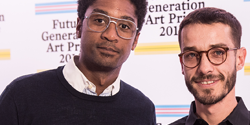
Carlos Motta (Colombia) and Nástio Mosquito (Angola) shared the Main Prize of the 3rd edition of the Future Generation Art Prize that was announced by the international jury at the award ceremony in the PinchukArtCentre, Kyiv, Ukraine on Dec 6, 2014. Artists will share the award of $100,000 ($60,000 in cash and $40,000 to be invested in the production of new works).
Future Generation Art Prize is the first global art prize for artists up to 35 founded by the Victor Pinchuk Foundation in 2009 with the aim of acknowledging and giving long-term support to a future generation of artists wherever they live and work.
The winners were chosen by the respected international jury consisting of Francesco Bonami – Curator, Director of the 50th Biennale di Venezia (Italy); Jan Fabre – Artist (Belgium); Doris Salcedo – Artist (Colombia); Eckhard Schneider – General Director of the PinchukArtCentre (Ukraine); Bisi Silva – Independent curator, Director for the Centre for Contemporary Art, Lagos (Nigeria); Adam Szymczyk – Artistic director of documenta 14 (Poland) and Philip Tinari – Director of the Ullens Center for Contemporary Art in Beijing (China).
Carlos Motta and Nástio Mosquito, as the Winners of the Main Prize, both will present their solo shows in the PinchukArtCentre in Kyiv in autumn 2015.
Introducing Nástio Mosquito, the Main Prize Winner, the jury stated: “Combining text, performance, video and installation in a distinctly original manner, Mosquito re-invents storytelling for our current moment. In complex vignettes that evoke a long tradition of spoken word poetry and musical improvisation, he brings an alternative dimension to the way in which we experience art, as well as the fraught realities of our global society.
His seemingly playful performativity becomes a framework for addressing themes that range from colonial history to changing geopolitical dynamics to human relationships. To achieve this, technology as well as popular culture plays an important role through his integration of the tools of DJ’s, VJ’s, TV-shows, youtube, and other devices characteristic of our media-saturated age. Mosquito’s powerful personal presence, adept sense of spatial dynamics, and sharp humor combine to challenge our perceptions of what we consider comfortably familiar.”
In their comments about Carlos Motta, who shared the Main Prize in 2014, the jury stated: “The presentation of Carlos Motta was consistent, complex and with well articulated ideas. In addition to that it displayed imagination and poetry in using narratives, fictional and otherwise, to structure a meditation on a set of urgent themes. Using the language of a historical museum display and fabricating cultural material, Motta constructs a context that allows him to take the pre-colonial heritage and colonial history of Latin America as a starting point for a deeply personal exploration.
This discourse has been extended to the local Ukrainian context, through the work ‘Brief history of homosexual repression in Ukraine’, a broadsheet that continues a project of the artist’s local researches in different countries into the history of LGBT rights. The jury was profoundly impressed by his ability to parlay formal precision, historical research and social commitment into work that offers new insights into how art can address fragile marginalized histories and advocate their importance.”
Addressing the young artists Victor Pinchuk, founder of the Future Generation Art Prize said: “I believe contemporary art is linked to freedom and openness. With all you here, I see Kyiv again become a strong center of this positive change energy. Look 600 kilometers to the East and you will understand what I mean. In Donetsk in Eastern Ukraine, a contemporary art centre was recently turned into a prison. First, the artists were chased out. Now people are incarcerated in horrible conditions and tortured there. For me, this is tragical - but logical. It is like a law of nature: Repressive regimes hate contemporary art. They fear it, they stop it, they forbid it. They want to control where contemporary art liberates.
And there is nothing more dissident, more different, than contemporary art and contemporary artists. We have invested into Ukrainian art scene, and into international young artists. To create a network connecting the best of those who create openness, freedom, change. I am proud of our investment. I hope it will prove useful for my country in difficult times.”

According to the decision of the jury additional $20,000 will be allotted by the PinchukArtCentre to fund artist-in-residency program to the Special Prize Winners - Aslan Gaisumov (Russia), Nikita Kadan (Ukraine) and Zhanna Kadyrova (Ukraine).
Commenting on works by Aslan Gaisumov the jury stated: “A poetic journey through the city of Grozny, Gaisumov’s video explores through both its subject matter and filmic devices the layering of histories—Soviet, wartime, and neoliberal—that characterizes this famously troubled place. Toggling through an actual destroyed local theatre, the work vacillates between straightforward projection and mediation, adding another valence to a dialectic between memory and reality.”
Introducing Nikita Kadan the jury members said: “Drawing on the distinctive visual languages of Soviet domesticity, provincial museology, and socialist modernity, Kadan produces a scene which, through the haunting presence of seemingly disparate elements, succeeds in estranging the viewer even as it evokes the indeterminacy of human conflict.”
And talking about the works of Zhanna Kadyrova the jury stated: “Four panoramic photographs depicting the typical skyline of Kiev’s residential areas are interrupted by splashes reminiscent of explosions which establish a parallel between the violence of war and material intervention into the formal unity of the photographic image. Silently and poetically, Kadyrova’s work articulates the present in an open-ended manner that allows for individual readings.”
Following the links you can download the images of the ceremony as well as portrait images of the winners and installation shots of their works:
Profiles of the winners:
The images from the Award Ceremony.
Images of the works presented at the exhibition of 21 shortlisted artists.



